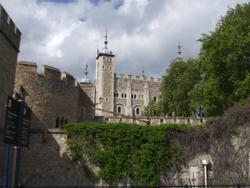 People often ask me where exactly was Anne Boleyn executed at the Tower of London and where exactly was she imprisoned. It’s good to know these facts when you go to the Tower of London because you can look for these places and pause for a moment and think of Anne and her story.
People often ask me where exactly was Anne Boleyn executed at the Tower of London and where exactly was she imprisoned. It’s good to know these facts when you go to the Tower of London because you can look for these places and pause for a moment and think of Anne and her story.
But do you know the facts? Do you know where Anne Boleyn was held prisoner and where she was executed?
Anne Boleyn’s Prison
As you know, Anne Boleyn was arrested on 2nd May 1536 at Greenwich Palace. Alison Weir writes of how Anne was accused of “evil behaviour” by Sir William Paulet, Sir William Fitzwilliam and her uncle, the Duke of Norfolk, charged with adultery and informed that both Mark Smeaton and Sir Henry Norris had confessed their guilt. Anne denied these charges but it was no good, she was allowed to return to her apartments for her dinner, under guard, and then she was escorted by barge along the Thames to the Tower of London.
Although Traitor’s Gate is often pointed out as the place where Anne would have disembarked, Alison Weir points out that Anne, as Queen, was taken to the Court Gate in the Byward Tower, a private entrance. Here she was met by the Lieutenant of the Tower, Sir Edmund Walsingham, who was Sir William Kingston’s deputy and then Anne would then have been escorted along Water Lane (in the Outer Ward), past the back of the Lieutenant’s House to the entrance of the royal palace where she was to be imprisoned.
It was ironic that Anne Boleyn was imprisoned in the same lodgings that she stayed in before her coronation in 1533 – the Queen’s apartments in the Tower’s royal palace.
But where are these lodgings?
In “The Lady in the Tower”, Weir describes Anne’s lodgings as lying “on the east side of the inner ward between the Lanthorn Tower and the Wardrobe Tower” and writes of how these apartments were renovated for Anne’s coronation, with Cromwell spending the equivalent of over £1 million pounds to make them fit for the new queen. These Renaissance style apartments were therefore a luxurious prison for Anne Boleyn but a prison is a prison. If you go to the Tower of London today, it is not possible to see Anne’s prison because these lodgings were uninhabitable by the end of the 16th century and demolished by the end of the 18th century. The present half-timbered Queen’s House which overlooks the green is not where Anne was imprisoned as these apartments were not built until around 1540, at least 4 years after Anne Boleyn’s execution.
If you look at the PDF map of the Tower of London at http://www.hrp.org.uk/Resources/Tower%20of%20London.pdf, Anne’s lodgings were apparently situated between the Lanthorn Tower and the Wardrobe Tower, on the South Lawn behind the White Tower (between 38 and 20, or 38 and the raven symbol). If you look at the following 1597 plan you will see the Queen’s Lodgings marked with a “g” – there is also a larger 1597 plan at our “The Tower of London in Anne’s Life” page.
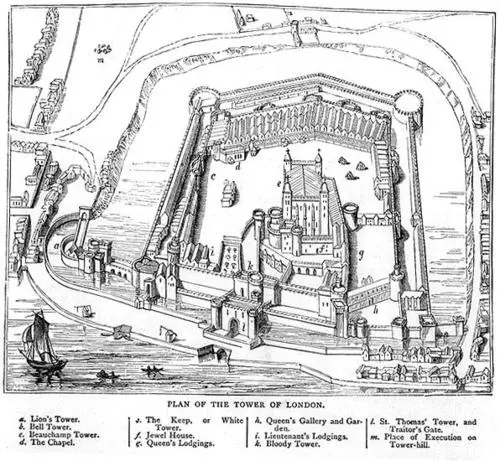
The following video gives you a 3D image of the Royal Palace as it would have been during the reign of Henry VIII:-
Anne Boleyn’s Execution
There is a beautiful glass monument on Tower Green which many take to be the place of the scaffold where Anne Boleyn was executed but her execution did not take place there at all. In “The Life and Death of Anne Boleyn”, Eric Ives writes:-
“It was a short journey. Out of the Queen’s Lodgings, past the Great Hall where she had dined on the night before her coronation, through the Cole Harbour Gate (marked Coldharbour Gate remains, number 11, on the map), along the west side of the White Tower and then the first sight of the scaffold.”
Alison Weir, in “The Lady in the Tower”, writes:-
“Anne was escorted across the palace courtyard and through the massive twin towers of the Coldharbour Gate, which stood to the west of the White Tower and led to the Inner Ward of the fortress. Ahead was the scaffold.”
Weir also writes that Anne’s scaffold was “erected on the present parade ground north of the White Tower” and if you look on the map of the Tower of London this is the area between the White Tower (43) and the Waterloo Barracks (40), so this is where you need to go and pause a while to think of Anne Boleyn.
Anne’s Resting Place
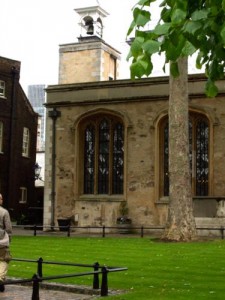
Anne’s body and head were placed in an elm chest, which had contained bow-staves for Ireland, and laid to rest in the Chapel of St Peter ad Vincula in the Tower grounds, number 10 on the Tower plan. Anne Boleyn was buried in a communal grave beneath the chancel pavement along with other people executed at the Tower.
In 1876, Queen Victoria gave permission for the chapel to be restored on the condition that if any remains were found that they were to be treated with respect and that careful records were kept of any evidence that could identify the remains. During the excavation, a skeleton thought to be Anne Boleyn was found “in the place where [she] is said to have been buried” (quoted in Weir), ony 2 feet below the floor of the chancel. Dr Frederic Mouat, the surgeon on the committe undertaking the excavation, examined the remains and Doyne Bell recorded his findings:-
“a female of between twenty-five and thirty years of age, of a delicate frame of body, and who had been of slender and perfect proportions; the forehead and lower jaw were especially well-formed. The vertebrae were particularly small.”
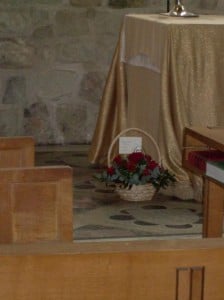
Dr Mouat concluded that the remains were at least three hundred years old and that they were “all consistent with the published descriptions of Queen Anne Boleyn, and the bones of the skull might well belong to the person portrayed in the painting by Holbein in the collection of the Earl of Warwick.”
However, Alison Weir argues against Dr Mouat’s findings, saying that not only is the age wrong but all of the authenticated portraits of Anne show her to have a pointed chin, rather than a “square, full chin” and that no portrait of Anne by Holbein is still in existence today. Weir writes:-
“It is just possible that the bones thought to be Anne Boleyn’s – the diminutive slender female with a square jaw – actually belonged to Katherine Howard, miniatures of whom by Holbein show her with what could be a jutting square jaw.”
She goes on to say that another skeleton, found in the place where Catherine Howard was thought to have been buried, was examined by Dr Mouat who concluded that they belonged to a female of “rather delicate proportions…of about thirty to forty years of age, probably forty years of age”. Weir believes that these bones belonged to the thirty-five year old Anne, not the other skeleton, hence:-
“we can be almost certain that Anne’s memorial stone does not mark the last resting place of her actual remains, and that she lies beneath Lady Rochford’s memorial.”
So, in Victorian time, was Catherine Howard buried as Anne Boleyn and Anne Boleyn buried as Lady Rochford? Perhaps so, although I do think the delicate hands with tapering fingers could well belong to Anne, mother of Elizabeth I who was so proud of her long and elegant fingers. Whatever the truth of the matter, Anne Boleyn’s remains do lie somewhere under the floor of the Chapel of St Peter ad Vincula, so pause a while in the Chapel and think of Anne.
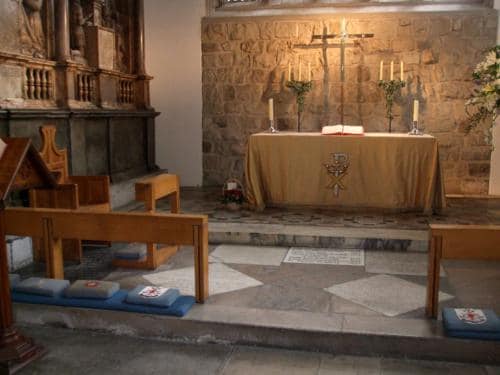
The Monument
The monument on Tower Green has the following words:-
“Gentle visitor pause a while,
Where you stand death cut away death cut away the light of many days.
Here, jeweled names were broken from the vivid thread of life.
May they rest in peace while we walk the generations around their strife and courage,
Under these restless skies.”
A beautiful poem! But Anne Boleyn was not the only person to have lost her life in the Tower grounds, think also of people like Sir Thomas More, Henry Norris, Mark Smeaton, William Brereton, Sir Francis Weston, George Boleyn, Catherine Howard, Lady Rochford, Lady Jane Grey and Guildford Dudley, Thomas Cromwell and Margaret Pole.
Sources
Photos of the Tower of London and Anne’s resting place by Paudie Kennelly.
Happy St Patrick Day to those of you in Ireland and those with Irish blood – have a great day! And don’t forget to check out the new jewelry – see New Jewelry from The Tudors.
Thanks for this Claire. It is quite confusing knowing where Anne was kept because different sources say different things. Likewise it is generally accepted that George was imprisoned in Martins Tower but I have never come across an actual primary source to confirm this. If he was, then when you look at a map of the Tower, you realise how far he had to walk in order to get to Tower Hill i.e. through the Tower, across one of the bridges and through the huge crowd up the hill to the scaffold.
Anne is rightly praised for her composure and bravery when facing death, but likewise, it is not until you really think about their last long walk that you fully realise how brave the five men who died with her were.
is this right? I thought that all of the men associated with Anne died on the Tower green scaffold where she was killed…… with the possible exception of Smeaton since he was “lower class.’
The primary sources all say that the men were executed on Tower Hill. Only very very important people were executed within the Tower confines, for example, Lady Jane Grey was executed within the Tower, but her husband, Guildford, was taken up to Tower Hill.
I thought I’d write about it because it is confusing as a lot of people suggest that Anne was kept in the “Queen’s House” overlooking the green and I had thought that was so until I researched it in more detail and found that those apartments weren’t even built until after Anne’s execution.
I know what you mean about their bravey, I just can’t imagine how it would feel knowing that you are condemned to death and just waiting for execution – makes getting scared about a dentist appointment seem a bit silly!! Poor George if he did have to walk all that way, how awful.
When we watch things like “The Tudors” and read about executions in books I think sometimes the enormity of what happened doesn’t hit us as we’re so used to violence on TV etc. but then it suddenly hits you that these were real people and they died an awful death and for what? To please a King? Horrible.
I think what you said is realy good and interesting
That’s so great!! I’m going to visit London- and the Tower- next week and this article is a wonderful coincidence! I’m going to walk where Anne has walked… so excited!! I am also visiting the Hampton Court!
Have a great time, Eliza! I am taking a copy of the old plan with me and I’m also going to mark the location on the modern day plan so that I can see the real place where Anne was executed.
Claire
As I have read so many articles concerning what Anne Boleyn looked like and that they are no surviving portraits of her, I often wonder why with all the developments in identification processes and procedures (such as recreating a model using the skull or using computer imaging) that no one has ever suggested this or done this using the two skulls that were found ?
It has been done with many of the remains that have been dug up in Egypt – why couldn’t it be done in England ?
Sherri
Sherri,
I was wondering the same thing. I think it would be a good idea to do that, although at the same time it would cost a lot of money to exhume the body and it might be considered disrespectful.
But i wish they would do it, I think she would like to be reconstructed properly.
Queen Elizabeth II has spoken about this matter and said that to re- (or re-re-re, who knows) exhume all of those who were so sadly buried in a communal and unmarked grave would be too costly and now there is a floor that I forgot the name of there that would be ruined, terribly expensive to replace.
I think she is right – stop a moment and think who would pay for this It is fair to add this burden to today’s British citizens? Just to appease curiosity? It would be extremely costly to hire people to … this all is sort of horrible to think of, for me, but to figure out who was where and re-inter their remains.
Belle, I have to disagree with you , if you are indeed speaking from Queen Anne’s perspective “I think she would like to be reconstructed properly”. That is not her. Her spirit is not there.
For me, when I die, I really don’t care what happens to my earthly remains, and I just mention this because it is still a belief of some Catholics, which we know Anne was not, that one must not be cremated, as “there will be no body to resurrect” in the teaching that one day, all who belong to Christ will be in heaven. I believe that we will receive a new, perfect, body in heaven.
From dust I am made and to dust I return…. I think that would have been more along the lines of what Anne professed to believe. So all of this exhuming really would be just to satisfy our curiosity – and I do agree it is terribly sad (it must have been horrid for Elizabeth!) to not be very careful and thoughtful regarding earthly remains. But Henry VIII just didn’t care. (I am not one who can find anything in him to like, obviously :)) But again, for me, I hope Anne is in heaven and had been since the moment her life on earth ended.
Wow, that was a great article. I have myself been many times to the Tower, but oh, how confusing it gets! I did try to locate Anne, to pause for a moment or something, but I couldn’t find her anywhere! In reading this it just seemed to dawn on me that, wherever she was, I was walkng ‘over’ her. Gives you a thrill, dosen’t it?
I enjoyed this section very much. Very informative. I live in Newfoundland, Canada.
I hope to visit London sometime. I read every book about Anne that I can find. Thank
you so much for this website.
I agree the the ladies who talk about facial reconstruction from skeletal remains. I have seen specials where they use skulls and this technology to reconstruct the faces of King Tut, Cleopatra, Cleo’s sister Arsinoe, and another special where they used life and death masks to reconstruct faces.
Knowing that Katherine and Anne’s bodies may have been switched might add prudence to the stories that the women haunt the Tower…to be buried under the wrong name would make me wonder aimlessly in the afterlife! =p I wonder if anyone has petitioned to have the bodies identified with DNA…
Again, I have to mention the cost of this. Maybe if a lot of private money were donated, but it should not fall on today’s taxpayers. And is there DNA of enough relatives to compare? Anne and Catherine Howard were of course first cousins, so that could cause further confusion.
And I don’t believe in unrest in the afterlife due to where the cast off “earth suit”, as my Mom calls it, ends up. By that logic, everyone who is not tidily buried under a nice rock with their name on it would now be a ghost 0) It would get pretty busy in places that have funeral pyres or who lay a body on a boat and Viking Funeral it up :0)
And again, IIRC, Queen Elizabeth II has already made a statement about this.
Thank you so much for this website. I am a HUGE Tudor history fan and of Anne Boleyn. I hope to someday go to England to visit the Tower Of London, Hampton Court, etc.
Sherri, Queen Elizabeth II will not allow any exhumations. Maybe someday, someone will allow exhumations, if anything, to at least give Anne Boleyn a more deserving burial.
There probably were mistakes made by the Vicorian era doctors, but I think the important thing is to remember how they lived and what they accomplished with their lives, which all ended so sadly. Anne is resting in peace with the others – I am a bit sentimental but I would like to think of her and her daughter somewhere up in heaven and knowing how much their courage and bravery have inspired so many. I think she would enjoy all the ladies getting dressed up as her, but even more so the positive “energy” created from so many people meeting to discuss her life and ultimately vindicating her and seeing her as more than the wife who was executed.
I wouldn’t be so quick to condemn our Queen as refusing permission for exhumation, Christina. I’d like to know where you obtained that piece of information. More likely than not, nobody has asked! She has always opened the Royal Collection to writers and art historians and altogether gone out of her way to help, as has Prince Philllip who gave blood to help DNA identify the Russian royal family.
I am lucky enough to work just around the corner to the Tower. I get to walk around it almost every day!
To Fiz,
well, to be honest i dont know Her Majesty and the royal family, but this information was also spread in the Czech republic. I`m just not shure whether it wasnt regarding lost princes and Richard III. story
To Fiz,
once more me:), i`m preparing for an exam (just a reference in english to confirm i`m able to study and dispute in english) and i have chosen already a topic…princes in the Tower and here i found a notice about a refusal :
“The Richard III Society unsuccessfully applied several times to obtain royal permission to exhume the bodies for further tests to prove his innocence”. taken from http://british-dark-middle-ages.suite101.com/article.cfm/the_princes_in_the_tower
so it was really regarding the princes. i just dont get it, wouldnt it be great to help revealing a mystery and important piece of history. Or there are maybe some religious reasons?
I find it extremely ironic that Anne Boleyn could be burried under Lady Rochfords memorial, i bet neither ladies would be pleased with that
Ironic? Given that there’s not a scrap of real evidence that Anne and Jane hated each other, then I fail to see how it’s ironic. Quite the contrary, actually, as the two women seemed to have been as close as they could be during the period they lived in, what with Jane (if I remember correctly) joining Anne’s ladies while KOA was still queen, and helping conspire against the mistress of Henry’s, and being close enough to Anne to discuss Henry VIII’s sexual impotence. It is horrible if it’s true that these two women are buried in the wrong graves, but by no means ironic.
Jane testified at trial that Anne slept with her own brother, Jane’s husband, and you think they liked each other?
HUH??
No, Jane did not testify at any of the trials. We know from the records that no witnesses were called and that the only evidence to back up the incest claim was that George used to spend time in Anne’s chambers. It is fiction that Jane was a witness or that she gave evidence regarding incest.
I have always been curious about Anne Boleyn, and this has
answered most of my questions! You’ve done an amazing job. Can you
answer a few further questions for me? Where the charges of
adultery against Anne ever proved? What did Elizabeth I, Anne’s
daughter, have to say about her mother? Did she believe the
charges? Lastly, was Henry VIII as much of a rotter as history
portrays him? If so, I pity him. Thanks! This was extremely
helpful. If you can’t or don’t get around to answering my
questions, don’t worry. I’m just curious.
Emma
No the charges of adultery were never definitely proven, and I believe Anne was innocent and that Henry cooked the whole thing up! Look up Anne Boleyns Fall on this website and Claire will explain the whole thing! Even though Elizabeth didn’t talk about her mother (as far as we know of) she did have a ring which concealed two secret images of Elizabeth and her mother. You should see it, it’s beautiful! I think that proves she didn’t think badly of Anne. Yes Henry was a rotter, nowadays he would be diagnosed as a sociopath! I don’t have any sympathy for him, not after what he did to Anne!
Hey Claire!
I have read that there were no official preparations for Anne’s burial after her execution, and thus is why she is buried in an arrow chest. I have also read that her body was left lying where it fell for a period of time before someone bothered to bury her. Is this true? Did Henry really not care enough about what happened to her body once she was dead?
Pleaae forgive me if this offends anyone, but has there been any discussion to have duplicates of the skulls made and to then have the faces reconstructed? I know this is done at times to help with unidentified bodies. How amazing it would be to look into Queen Anne or Queen Katherine’s faces!
the situation regarding exhumation of royal graves is relatively simple: the current monarch has the final say.
the current monarch is reputed – and i’ve heard this from a number of historians who are sufficiently eminent for them to know – to have almost no interest whatsoever in any of her predecessors past George V. she also has very strong religious/cultural attitudes to the sanctity of the dead: she simply does not believe that the solving of a 500 yo historical question is a good enough reason to disturb a grave.
i have heard (purely through departmental gossip) that she was considering allowing the investigation of the puzzling graves found in the tomb of Edward IV – in effect, the Princes in the Tower – but decided not on the basis of setting precedent: the argument being that if she allowed one 500yo Royal tomb to be disturbed, she would face pressure to allow other, more recent tombs to also be researched, and that at some point researchers would want to start digging up people she thinks of as ‘family’, and that she, or her successors, would have to acquiess on the basis of precedent having been set.
i’m given to understand that Charles has very similar views – though what William and Harry think is anyones guess: cod psycology however would suggest that for obvious reasons they probably aren’t keen on the idea of royal persons being dug up to satisfy the curiosity of the public…
in an ideal world we’d be able to research the tomb of Edward IV to attempt to solve the mystery of the Princes in the Tower (for the unitiated, there are two more coffins of children in his tomb than there should be…), take DNA from the grave of ‘Richard Plantagenet’ to see if he really was the son of Richard III, and compare DNA of Richard, 3rd Duke of York and Edward IV to prove or disprove the allegation that Edward was illigitimate – and thats for starters…
My strong personal belief is that someone, somewhere, wants something to remain hidden.
In an ideal world we would have respect the dead and not go around digging them up just to satisfy curious amateurs on websites.
Isn’t it time that the Tower of London corrects its mistake and correctly marks the place that Anne Boleyn was executed??
It’s a tough one. It’s in the middle of a parade ground and also where the queues for the crown jewels are, so I don’t think they could unless they laid a plaque into the ground. The glass memorial isn’t just for Anne, it’s for various prominent people who were executed on Tower Green, which did stretch round to where the parade ground is anyway in those days. I just wish they would point out that the memorial is just that, a memorial, and not a marker of the spot where it all take place.
My friend has a book by Linda Goodman “Star Signs” that states Anne Boleyn had a baby girl while she was in the tower and the father was supposedly one of the guards. The baby was hidden and taken from the tower and raised secretly. The name Minor Hughes was mentioned. I don’t believe it because I have read many many books on her and just can’t believe this to be true.
Anne was only in the Tower from 2nd May until 19th May so that really would be impossible. How bizarre! I’ve never heard that story before! Thanks for sharing.
I have to correct you on this, Ruby. I have this book, and Linda Goodman wrote that ‘history lied’, and just before Anne was beheaded, she gave birth to a premature red haired boy, by a jail keeper called Moner Hughes. She wrote that he smuggled the child out and that Howard Hughes was actually a descendant of that child. It’s on page 331, if anyone is interested.
i also have this book and have tried to research the matter I even contacted Joseph Gregory Hallet who claims to be the true king of England It is intresting that if true the distant relative would be Howard Hughes who did much work with both the Trump brothers Tesla and Van Graff It has always ran bells with me as Linda Goodman is no fool and i would love others to research this more
Anne was innoCent she should of not died. Henry the eight was an an iddiot. He is burning in hell now fat basturd
I have read before that when Anne was beheaded, her eyes continued to blink for a couple of seconds on her severed head, which convinced witnesses that she was in fact involved in witchcraft! Not sure how true that is or whether it’s just a myth?
when you die your brain is conscious for about 10 minutes remember the chicken that runs round after losing its head.its the same. We can hear and be aware of everything we just can not see or move.
I have seen the television serial The Tudors. Since then it has created an impact on my mind.
I hope you realise 90% of it was historically incorrect.